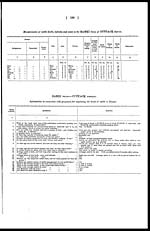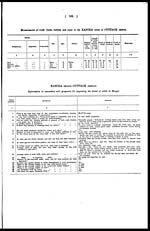Medicine - Veterinary > Civil Veterinary Departments > 1895-1951 - Annual report of the Civil Veterinary Department, Bengal > 1897-1898 - Annual report of the Civil Veterinary Department, Bengal, for the year 1897-98 > Annual report of the Civil Veterinary Department, Bengal, for the year 1897-98
(236) Page 190
Download files
Individual page:
Thumbnail gallery: Grid view | List view

( 190 )
Measurement of cattle (bulls, bullocks and cows) in the KUJANG estate of CUTTACK district.
|
BREED. |
Sex. |
Age. |
Colour. |
Height |
Length |
Girth at |
Girth of |
Girth of |
REMARKS. |
|||||
|
Indigenous. |
Imported. |
Cross- |
||||||||||||
|
1 |
2 |
3 |
4 |
5 |
6 |
7 |
8 |
9 |
10 |
11 |
12 |
|||
|
Yrs. |
Ft. |
In. |
Ft. |
In. |
Ft |
In. |
Ft. In. |
Ft. In. |
||||||
|
Bull ... ... ... |
... ... |
... |
Male ... |
9 |
Black ... ... |
4 |
5 |
4 |
7 |
6 |
0 |
... |
... |
Columns 10 and 11 |
|
Bullock ... ... |
... ... |
... |
Do. ... |
6 |
White ... ... |
3 |
6 |
3 |
1 |
4 |
3 |
... |
... |
|
|
Do. ... ... |
... ... |
... |
Do. ... |
5 |
Do. ... ... |
3 |
5½ |
3 |
2 |
4 |
3 |
... |
... |
|
|
Cow ... ... ... |
... ... |
... |
Female .. |
4 |
Do. ... ... |
3 |
5 |
3 |
0½ |
4 |
3¼ |
... |
||
|
Do. ... ... ... |
... ... |
... |
Do. ... |
7 |
Do. ... ... |
3 |
10 |
3 |
2 |
4 |
2½ |
... |
... |
F.R. |
KUJANG ESTATE—CUTTACK DISTRICT.
Information in connection with proposals for improving the breed of cattle in Bengal.
|
Serial |
Questions. |
Answers. |
|
1 |
2 |
3 |
|
1 |
What is the total land area of the subdivision (cultivated, grazing, and |
The total land area of killa Kujang is 236,825.84 acres, of which 114,964.28 |
|
2 |
Is any land available on a Government estate or otherwise, and if so, |
It could not be known what kind of land is required for cattle-breeding. |
|
3 |
How are cattle fed, whether stall-fed or grazed, or both ; and whether |
The cattle are chiefly grazed. During the rainy season the cattle are fed |
|
4 |
Is grazing scarce or plentiful? ... ... ... ... ... ... ... |
Not scarce during the dry season. |
|
5 |
Is there any scarcity of drinking-water for cattle? ... ... ... |
No. |
|
6 |
Are the cattle sheltered during the winter and rains ? ... ... ... |
Yes, in all seasons. |
|
7 |
Number of bulls in proportion to cows, and whether sufficient or not ? ... |
The number of bulls is about 295, and that of cows about 29,049 in the |
|
8 |
Do the calves have all the cows' milk ; if not, how much ? ... ... |
The calves have all the cows' milk for 3 weeks or a month from the date |
|
9 |
At what age are calves weaned, and how are they fed after weaning? ... |
The calves are weaned when they are 8 to 12 months old, and after weaning |
|
10 |
At what age are bull-calves gelded, and when do they begin work ? ... |
They are gelded when they are a year old, and they begin work at their |
|
11 |
Is fodder stored for cattle, and if so, what does it comprise ? ... ... |
Yes, specially for the rainy season, only straw is stored. |
|
12 |
Average yield of milk, and how long after calving do the cows continue |
The daily average yield of milk per cow is from ½ a seer to 1 seer, and |
|
13 |
Average price of local bulls, cows, and bullocks? ... ... ... ... |
Bulls are not sold here. Milch cows sell at Rs. 6 to Rs. 10, and bullocks |
|
14 |
Ditto of imported ditto ... ... ... |
None imported. |
|
15 |
Whence do the imported cattle come, and for what purpose are they |
None imported. |
|
16 |
Is there any special system of cattle management in your subdivision ... |
None. |
|
17 |
What is the average height of the best bulls behing hump? ... ... |
The average height of best bulls bebind hump is 4 feet 5 inches. |
|
18 |
What is the average height of the worst bulls behind hump? ... ... |
The average height of a worst bull behind hump is 4 feet 2½ inches. |
|
19 |
What is the average height of cows? ... ... ... ... ... ... |
The average height of cows is 4 feet nearly. |
|
20 |
Are Brahmini bulls let loose ... ... ... ... ... ... ... |
Yes, all the bulls are let loose. |
|
21 |
1 Are there too many Brahmini bulls ? ... ... ... ... ... ... |
As above, vide paragraph 7. |
Set display mode to: Large image | Zoom image | Transcription
Images and transcriptions on this page, including medium image downloads, may be used under the Creative Commons Attribution 4.0 International Licence unless otherwise stated. ![]()
| Permanent URL | https://digital.nls.uk/76342116 |
|---|




